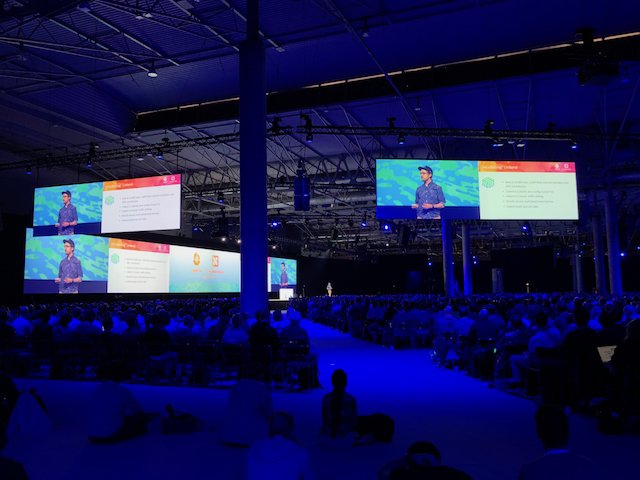
May Community Meeting Recap Part 1
May’s Community Meeting was a little different than our typical meetups. Hot off a successful KubeCon EU (at least from a Linkerd perspective), we chose to recap the great Linkerd stories told during the conference. Also featured was an amazing talk by Linkerd maintainer, Matei Davis, on multi-cluster with headless services.
Because this meeting yielded such great content, we’re splitting the recap into two blogs. Today, we’ll focus on KubeCon EU.
Before we get started, just a quick reminder of the Linkerd Anchor program. If you have a great Linkerd story, we’d love to help you tell it. We can assist with the writing process, reviewing code, or providing guidance on how to create a helpful video tutorial. Complete this form and we’ll reach out!
Linkerd at KubeCon EU 2021
Here’s a quick overview of each Linkerd talk at KubeCon EU 2021 along with the video recording.
Why the future of the cloud will be built on Rust
In his Cloud Native Rust Day talk, Buoyant CTO, Oliver Gould, notes that system programming differs from application programming and requires a different language like Rust. Apps that are written in Rust provide the confidence in memory safety and reliability that infra teams need.
Rust is a great language for that purpose because it has a robust safety net. It requires error handling and prevents runtime errors, safe concurrency in isolation with the borrow checker, and follows a “resource acquisition is initialization” (RAII) model. Tokio and Tonic offer mature networking functionality while kube-rs (client-go for Rust) is one to watch.
Panel Discussion: Rust in the Cloud
In this Cloud Native Rust Day panel discussion, Paul Howard (Arm), William Morgan (Buoyant), Oliver Gould (Buoyant), Ashley Williams (Rust Foundation), and Carl Lerche (Amazon) agreed that Rust front-loads the application maintenance burden and is extremely secure and performant.
Rust is still new and the community is heavily invested in improving the developer experience. Even though it has a steep learning curve, there is excellent developer tooling. All panelists were confident that we’ll see a lot of investment in this language moving forward and encourage everyone who hasn’t tried Rust, to do so now.
Scheduling 68k COVID Tests with Linkerd
Dom DePasquale and Shawn Smith from the Pennsylvania State University discussed how they scheduled 68,000 COVID tests before the fall semester started. To do that, they needed a service mesh that was simple and provided mTLS and free retries. While observability was the most critical feature for this project, multi-cluster and traffic split came in handy.
Rapid Experimentation Simplified with Linkerd
Before joining Civo, Alexander Simon Jones worked at a multi-national financial institution where the team used Linkerd to simplify experimentation. He’s been a big proponent of using service meshes for that purpose ever since. Here are his main takeaways:
- A service mesh is a key component to rapid experimentation, both for traffic splitting and observability
- Standardized metrics simplify experimentation
- A service mesh helps operations and QA team build out experiments
Tap Tap, Debugging an App with your Service Mesh
In his ServiceMeshCon talk, Jason Morgan, Tech Evangelist at Buoyant, shows how easy it is to debug an app with Linkerd. The Linkerd tap tool inspects traffic flowing through the service mesh. With debugging tools like Tap, service graphs, and routes, the mean time to resolution (MTTR) is significantly shorter.
Creating Chaos in the University with Linkerd and Chaos Mesh
Computer science student, Jossie Bismarck Castrillo Fajardo, and his professor, Sergio Arnaldo Méndez Aguilar, discuss the hows and whys of chaos experimenting. During their ServiceMeshCon talk, they discuss using Chaos Mesh and Linkerd to inject faults and failures. If you’d like to try it yourself, Jossie and Sergio shared their repo for anyone to reproduce their experiments.
Panel: The State of Service Mesh
This panel, which included William Morgan (Buoyant), Idit Levine (Solo.io), Nic Jackson (Hashicorp), Marco Palladino (Kong Inc), Louis Ryan (Google), and Lin Sun (Solo.io) covered a lot of ground. For instance, how should users decide if they need a service mesh? According to the panelists, enterprises must decide whether they want to write and maintain code that a service mesh provides or have a platform team that supports a service mesh. Either way, they do need that functionality — there is no way around that.
Over the past few years, the state of the service mesh has evolved. Not too long ago, enterprises asked themselves if they needed a service mesh. Today, the question is rather when should they adopt one. While the service mesh has become socially easier to adopt, practically it’s still challenging. More vendors translate into more decision complexity.
William concluded with a quick overview of what’s next for Linkerd. Users will soon see policy updates including configuring and enforcing rules about how services communicate with each other. Modularity through extensions is only highly encouraged.
Compliance the Easy Way: Zero-conf mTLS for Dev and Smooth Day-2 for Ops
Christian Hüning and Lutz Behnke from the German-based fintech startup Finleap Connect (which adopted Linkerd after struggling with Istio) shared their journey to mTLS. In their KubeCon talk, they discuss how they implemented mTLS without needing their dev team to do any work. The service mesh enabled them to easily scale to over 5,000 pods. And, after externalizing Prometheus, the team helped Linkerd evolve. By the way, their help with the cert-manager integration was fundamental and much appreciated by everyone at Linkerd!
Seamless Multi-Cluster Communication and Observability with Linkerd
Max Körbächer from Liquid Reply provided a great breakdown of when it makes sense to use multi-cluster. As he’s experienced in his client work, organizations are increasingly considering multi-cluster architectures; yet knowledge, complexity, security, and networking are common application architecture pain points. Linkerd is great for multi-cluster use cases and, based on an example, Max showcases how the service mesh has become a lot easier to handle.
Keynote: Linkerd vs. COVID-19: Addressing the global Pandemic with a Service Mesh
In William Morgan’s KubeCon keynote, he shares some examples of how organizations like NIH, Clover Health, Penn State, and H-E-B, have been using Linkerd in their effort to face COVID-19 challenges.
Overview and State of Linkerd
KubeCon wouldn’t be KubeCon without the “Overview and State of Linkerd”. William Morgan and Matei David delivered a quick overview of the state of Linkerd, why we are witnessing an increase in adoption, and what drives this great and welcoming community. They discussed the problems the service mesh solves, its continuous commitment to simplicity, as well as recent and upcoming features.
This concludes part one of our Community Meeting recap. In part two, we’ll focus on Matei’s multi-cluster with headless services presentation, so stay tuned. And don’t forget to register for our upcoming meeting on June 24 at 9 a.m. PT / 12 p.m. ET. We hope to see you there!


